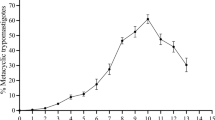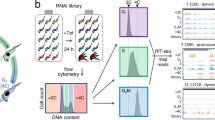Abstract
As Trypanosoma cruzi, the etiological agent of Chagas disease, multiplies in the cytoplasm of nucleated host cells, infection with this parasite is highly likely to affect host cells. We performed an exhaustive transcriptome analysis of T. cruzi-infected HeLa cells using an oligonucleotide microarray containing probes for greater than 47,000 human gene transcripts. In comparison with uninfected cells, those infected with T. cruzi showed greater than threefold up-regulation of 41 genes and greater than threefold down-regulation of 23 genes. Real-time reverse transcriptase-polymerase chain reaction (RT-PCR) of selected, differentially expressed genes confirmed the microarray data. Many of these up- and down-regulated genes were related to cellular proliferation, including seven up-regulated genes encoding proliferation inhibitors and three down-regulated genes encoding proliferation promoters, strongly suggesting that T. cruzi infection inhibits host cell proliferation, which may allow more time for T. cruzi to replicate and produce its intracellular nests. These findings provide new insight into the molecular mechanisms by which intracellular T. cruzi infection influences the host cell, leading to pathogenicity.

Similar content being viewed by others
References
Baert JL, Beaudoin C, Monte D, Degerny C, Mauen S, de Launoit Y (2007) The 26S proteasome system degrades the ERM transcription factor and regulates its transcription-enhancing activity. Oncogene 26:415–424
Banerjee S, Saxena N, Sengupta K, Tawfik O, Mayo MS, Banerjee SK (2003) WISP-2 gene in human breast cancer: estrogen and progesterone inducible expression and regulation of tumor cell proliferation. Neoplasia 5:63–73
Brener Z (1973) Biology of Trypanosoma cruzi. Annu Rev Microbiol 27:347–382
Burleigh BA (2004) Probing Trypanosoma cruzi biology with DNA microarrays. Parasitology 128(Suppl):S3–S10
Burleigh BA, Woolsey AM (2002) Cell signalling and Trypanosoma cruzi invasion. Cell Microbiol 4:701–711
Chen YG, Lui HM, Lin SL, Lee JM, Ying SY (2002) Regulation of cell proliferation, apoptosis, and carcinogenesis by activin. Exp Biol Med (Maywood) 227:75–87
Chen C, Ouyang W, Grigura V, Zhou Q, Carnes K, Lim H, Zhao GQ, Arber S, Kurpios N, Murphy TL, Cheng AM, Hassell JA, Chandrashekar V, Hofmann MC, Hess RA, Murphy KM (2005) ERM is required for transcriptional control of the spermatogonial stem cell niche. Nature 436:1030–1034
Clark RK, Kuhn RE (1999) Trypanosoma cruzi does not induce apoptosis in murine fibroblasts. Parasitology 118:167–175
Dadke D, Jarnik M, Pugacheva EN, Singh MK, Golemis EA (2006) Deregulation of HEF1 impairs M-phase progression by disrupting the RhoA activation cycle. Mol Biol Cell 17:1204–1217
de Launoit Y, Baert JL, Chotteau-Lelievre A, Monte D, Coutte L, Mauen S, Firlej V, Degerny C, Verreman K (2006) The Ets transcription factors of the PEA3 group: transcriptional regulators in metastasis. Biochim Biophys Acta 1766:79–87
Eickhoff CS, Eckmann L, Hoft DF (2003) Differential interleukin-8 and nitric oxide production in epithelial cells induced by mucosally invasive and noninvasive Trypanosoma cruzi trypomastigotes. Infect Immun 71:5394–5397
Gao W, Pereira MA (2002) Interleukin-6 is required for parasite specific response and host resistance to Trypanosoma cruzi. Int J Parasitol 32:167–170
Gross I, Bassit B, Benezra M, Licht JD (2001) Mammalian sprouty proteins inhibit cell growth and differentiation by preventing ras activation. J Biol Chem 276:46460–46468
Guerra S, López-Fernández LA, Conde R, Pascual-Montano A, Harshman K, Esteban M (2004) Microarray analysis reveals characteristic changes of host cell gene expression in response to attenuated modified vaccinia virus Ankara infection of human HeLa cells. J Virol 78:5820–5834
Hashimoto M, Nakajima-Shimada J, Aoki T (2005) Trypanosoma cruzi posttranscriptionally up-regulates and exploits cellular FLIP for inhibition of death-inducing signal. Mol Biol Cell 16:3521–3528
Hassan GS, Mukherjee S, Nagajyothi F, Weiss LM, Petkova SB, de Almeida CJ, Huang H, Desruisseaux MS, Bouzahzah B, Pestell RG, Albanese C, Christ GJ, Lisanti MP, Tanowitz HB (2006) Trypanosoma cruzi infection induces proliferation of vascular smooth muscle cells. Infect Immun 74:152–159
Imai K, Mimori T, Kawai M, Koga H (2005) Microarray analysis of host gene-expression during intracellular nests formation of Trypanosoma cruzi amastigotes. Microbiol Immunol 49:623–631
Itoh N, Ornitz DM (2004) Evolution of the Fgf and Fgfr gene families. Trends Genet 20:563–569
Janknecht R, Monté D, Baert JL, de Launoit Y (1996) The ETS-related transcription factor ERM is a nuclear target of signaling cascades involving MAPK and PKA. Oncogene 13:1745–1754
Kamikubo Y, Nakahara Y, Takemoto S, Hamuro T, Miyamoto S, Funatsu A (1997) Human recombinant tissue-factor pathway inhibitor prevents the proliferation of cultured human neonatal aortic smooth muscle cells. FEBS Lett 407:116–120
Kwabi-Addo B, Ozen M, Ittmann M (2004) The role of fibroblast growth factors and their receptors in prostate cancer. Endocr Relat Cancer 11:709–724
Liu Y, Jiang H, Crawford HC, Hogan BL (2003) Role for ETS domain transcription factors Pea3/Erm in mouse lung development. Dev Biol 261:10–24
Maeshima K, Takahashi T, Nakahira K, Shimizu H, Fujii H, Katayama H, Yokoyama M, Morita K, Akagi R, Sassa S (2004) A protective role of interleukin 11 on hepatic injury in acute endotoxemia. Shock 21:134–138
Morel CM, Lazdins J (2003) Chagas disease. Nat Rev Microbiol 1:14–15
Nakajima-Shimada J, Zou C, Takagi M, Umeda M, Nara T, Aoki T (2000) Inhibition of Fas-mediated apoptosis by Trypanosoma cruzi infection. Biochim Biophys Acta 1475:175–183
Saavedra E, Herrera M, Gao W, Uemura H, Pereira MA (1999) The Trypanosoma cruzi trans-sialidase, through its COOH-terminal tandem repeat, upregulates interleukin 6 secretion in normal human intestinal microvascular endothelial cells and peripheral blood mononuclear cells. J Exp Med 190:1825–1836
Sangari FJ, Petrofsky M, Bermudez LE (1999) Mycobacterium avium infection of epithelial cells results in inhibition or delay in the release of interleukin-8 and RANTES. Infect Immun 67:5069–5075
Schwertschlag US, Trepicchio WL, Dykstra KH, Keith JC, Turner KJ, Dorner AJ (1999) Hematopoietic, immunomodulatory and epithelial effects of interleukin-11. Leukemia 13:1307–1315
Shepherd TG, Kockeritz L, Szrajber MR, Muller WJ, Hassell JA (2001) The pea3 subfamily ets genes are required for HER2/Neu-mediated mammary oncogenesis. Curr Biol 11:1739–1748
Tashiro E, Minato Y, Maruki H, Asagiri M, Imoto M (2003) Regulation of FGF receptor-2 expression by transcription factor E2F-1. Oncogene 22:5630–5635
Tsavachidou D, Coleman ML, Athanasiadis G, Li S, Licht JD, Olson MF, Weber BL (2004) SPRY2 is an inhibitor of the ras/extracellular signal-regulated kinase pathway in melanocytes and melanoma cells with wild-type BRAF but not with the V599E mutant. Cancer Res 64:5556–5559
Vaena de Avalos S, Blader IJ, Fisher M, Boothroyd JC, Burleigh BA (2002) Immediate/early response to Trypanosoma cruzi infection involves minimal modulation of host cell transcription. J Biol Chem 277:639–644
Vaux DL, Haecker G, Strasser A (1994) An evolutionary perspective on apoptosis. Cell 76:777–779
Wakioka T, Sasaki A, Kato R, Shouda T, Matsumoto A, Miyoshi K, Tsuneoka M, Komiya S, Baron R, Yoshimura A (2001) Spred is a Sprouty-related suppressor of Ras signalling. Nature 412:647–651
Wang HT, Kong JP, Ding F, Wang XQ, Wang MR, Liu LX, Wu M, Liu ZH (2003) Analysis of gene expression profile induced by EMP-1 in esophageal cancer cells using cDNA Microarray. World J Gastroenterol 9:392–398
Weber A, Hengge UR, Bardenheuer W, Tischoff I, Sommerer F, Markwarth A, Dietz A, Wittekind C, Tannapfel A (2005) SOCS-3 is frequently methylated in head and neck squamous cell carcinoma and its precursor lesions and causes growth inhibition. Oncogene 24:6699–6708
Yasukawa H, Sasaki A, Yoshimura A (2000) Negative regulation of cytokine signaling pathways. Annu Rev Immunol 18:143–164
Acknowledgement
This work was supported in part by Grants-in-Aid (Nos. 17390123 and 18790297) for Scientific Research from the Ministry of Education, Sports, Science, Culture, and Technology (ESSCT) of Japan. This study was in part supported by the High Technology Research Center Grant from Ministry of ESSCT of Japan. MH and TA are supported by 21st Century COE Research from the Ministry of ESSCT of Japan. MH is supported by a Grant-in-Aid for 21st Century COE Research.
Author information
Authors and Affiliations
Corresponding author
Rights and permissions
About this article
Cite this article
Shigihara, T., Hashimoto, M., Shindo, N. et al. Transcriptome profile of Trypanosoma cruzi-infected cells: simultaneous up- and down-regulation of proliferation inhibitors and promoters. Parasitol Res 102, 715–722 (2008). https://doi.org/10.1007/s00436-007-0819-x
Received:
Accepted:
Published:
Issue Date:
DOI: https://doi.org/10.1007/s00436-007-0819-x




